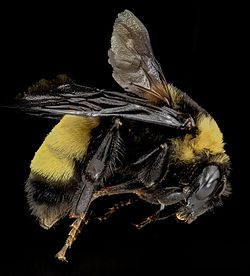| Bombus auricomus | |
|---|---|
 | |
| Scientific classification | |
| Kingdom: | Animalia |
| Phylum: | Arthropoda |
| Class: | Insecta |
| Order: | Hymenoptera |
| Family: | Apidae |
| Genus: | Bombus |
| Subgenus: | Bombias |
| Species: | B. auricomus |
| Binomial name | |
| Bombus auricomus (Robertson, 1903) | |

Bombus auricomus is a species of bumblebee known by the common name black and gold bumblebee. [1] It is native to eastern North America, including Ontario in Canada and much of the eastern United States, as far west as the Great Plains. [1]
This species creates above-ground nests in grassland and other open habitat types. It feeds at many types of plants, including thistles, prairie clovers, delphiniums, teasels, echinacea, bergamot, penstemons, clovers, and vetches. [1]
This is a fairly large bumblebee; workers and males are about 1.7 to 2.0 cm long, while queens can be up to 2.5 cm in length. [2]
This bee was previously thought to be conspecific with the Nevada bumblebee (B. nevadensis), but the two are now considered separate species. [1]
